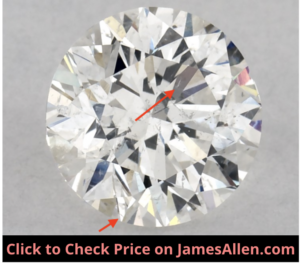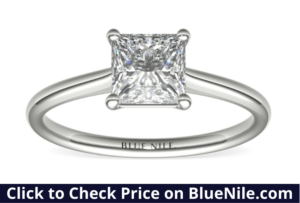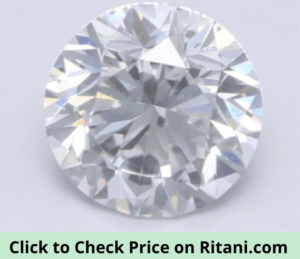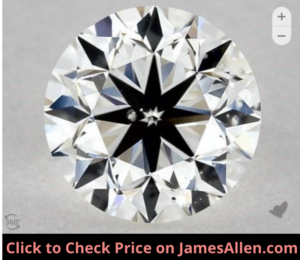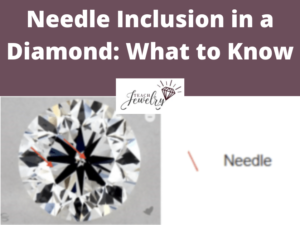
Diamond inclusions affect more than its visible appearance. They have the potential to impact its brilliance, durability, and overall appeal.
One common flaw you’ll find is a needle inclusion.
Let’s explore everything to know about needle inclusions in a diamond, including how they develop, finding them on a grading report, if they can be removed, and more.
What are Needle Inclusions?
Needle inclusions are thin lines inside a diamond’s facets that result from small crystals experiencing intense heat.
It’s a miniscule diamond crystal within the larger diamond.
The blemish belongs to the same category as pinpoints and clouds.
Pinpoints don’t stretch into lines like needles. Instead, they’re tiny dots. Clusters of crystals make up clouds, as opposed to singular needles that extend across its facets.
Needles are one of the least impactful inclusions and often invisible to the naked eye.
For example, check out this one-carat diamond, where I’ve highlighted the location of its needles.
It earned a VS2 clarity grade, and needles are present in several locations.
They’re barely visible in the high-resolution image, but try zooming in on the diamond to better spot them.
Needles are generally white or transparent, which disguises them, but gemologists identify them with 10x magnification during the grading process.
You may notice needles if there are several located near each others or if one is particularly long.
Needles on Diamond Grading Reports
If needles are found in a diamond during its evaluation, it’ll be noted on the grading report.
Like all other inclusions, it’s identified with a symbol on the clarity characteristics plot. The symbol is a straight red line, seen below.

Let’s use the grading report for this round-cut diamond as an example.
The Gemological Institute of America (GIA) report identifies several occurrences of needles.
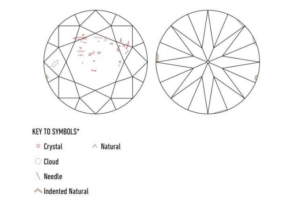
Some are located in the middle of the diamond’s table.
This is in addition to seven other types of inclusions, such as indented naturals, crystals, and clouds.
When examining it through a high-quality image, only a few needles are apparent. It changes depending upon the angle.
Also note the size of needles on diamond grading reports. They’re drawn to scale.
A large needle that spans multiple facets is more likely to be visible compared to one that’s short. In fact, some are so small they mimic pinpoints.
This underlies the importance of choosing a diamond graded by a reliable gemologist, so you can learn how its needle inclusions affect quality.
Can Needles be Removed from a Diamond?
Needles and other inclusions can often be removed from diamonds, but that doesn’t mean I recommend it.
The process generally involves cutting away the portion of the diamond with the inclusion and re-polishing the gem, or treatments like clarity-enhancement attempt to hide dark marks.
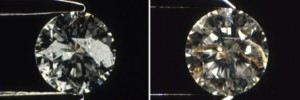
Even though it may result in an eye-clean diamond, its value often diminishes.
Treated diamonds where needles are removed are often worth less than ones without modification.
There is rarely an instance in which needles would have the type of impact that mandates removing them.
In most cases, they’re invisible when viewed in a normal setting and don’t affect the stone’s brilliance or durability.
This is especially true if you’ve chosen a diamond with a clarity grade like SI1 or VS2.
It’s unlikely needles would be the most impactful inclusions when there are also feathers or twinning wisps.
So if you wanted to remove any imperfection, you’d have to go beyond needles and significantly alter the stones appearance and structure.
I recommend choosing a diamond with a high enough clarity grade that doesn’t necessitate removing needles or other inclusions. It’s worth the premium, and you’ll avoid the risks it poses to your diamond.
How Do They Affect Price?
It’s difficult to isolate the effect of needle inclusions on a diamond’s price, but I can determine how the overall presence of blemishes influences cost.
Diamonds are graded on a clarity scale that indicates how its inclusions affect its quality. Specifically, this includes brilliance, durability, and visible appearance.
Vendors charge premiums for diamonds that land higher on the scale, which starts at flawless and ends at I3 (included).
The best way to learn how needles affect the price of a diamond is to compare costs for diamonds that have all the same qualities except for their clarity.
I assessed prices for 82 diamonds from James Allen with the following grades:
- Carat weight: 0.80
- Cut: Very good
- Color: F
For VS2 diamonds, the average selling price was $3,573, with a range of $2,930-$3,780.
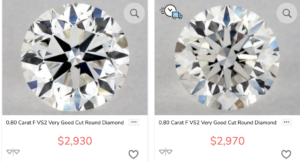
By moving up one position on the clarity scale to VS1, the average price increased seven percent to $3,826. The range was $3,420-$4,450.
This demonstrates how inclusions like needles can determine a diamond’s price.
If several long needles cause a diamond to earn a lower clarity grade, you can expect the price to drop five to 20 percent.
My recommendation is to land on a diamond where you avoid the premiums of the highest clarity grades such as VVS1, internally flawless, and flawless, but it’s still eye-clean. This means it appears flawless without magnification.
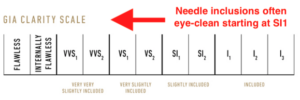
For diamonds around one-carat, this is generally the SI1 to VS1 range.
How Do Needles Compare to Other Inclusions?
Certain inclusions are more impactful than others. Needles rank low on this list compared to other inclusions.
You can generally categorize inclusions by how they alter a diamond’s durability, light performance, and visual appeal.
Large inclusions like feathers and cavities located on a weak point in a diamond leave it vulnerable to chipping.
For example, inclusions on the corner of this princess cut should be protected with a quality setting.
Clouds that distort the way light enters and exits facets reduce scintillation.
Several black spots scattered across its table diminish the appearance of an engagement ring diamond.
Let’s look at a few examples to learn how needles compare to other inclusions.
This diamond earned an SI2 clarity grade.
The main reason appears to be the black spot in the middle of the diamond, in addition to several crystals in that area.
There are needles on the outer edge, but they’re invisible without magnification.
The GIA report also shows they’re small, which reduces prominence.
This SI1 diamond has several clouds and pinpoints, which diminishes its clarity.
Needles are often one of the least impactful because of their size and color. A tiny, white and thin needle doesn’t compare to a significant dark crystal or chip.
These rank among the inclusions you should avoid.
While you should always examine the grading report and view the diamond in person or through high-quality images, you’ll likely focus more on clarity characteristics other than needles in deciding which diamond is right for you.
Should You Avoid a Diamond with Needles?
Don’t avoid a diamond solely because of needle inclusions. Unless you’re willing to pay a premium for a flawless diamond, there will be inclusions present within its facets.
The important aspect to consider is their overall effect on the stone.
Because of this, you can still find a quality, eye-clean diamond with needles. Even if they’re positioned in several locations across the diamond, it shouldn’t be a dealbreaker.
Check out the grading report to learn their size and location. View the diamond through magnification in person or online to ensure they’re small and not dark.
By understanding needle inclusions and how they should influence your decision, you can land on the right diamond for you.

Jacob Clarke
Jacob Clarke is the founder of TeachJewelry.com.
He earned an Applied Jewelry Professional Diploma from the Gemological Institute of America (GIA) and now brings you essential information about diamonds, settings, and more.
Jacob has consulted with leading jewelry brands, and his work has been cited in Clean Origin, Diamond Nexus and industry publications.
He's also a member of the International Gem Society.
He enjoys discussing jewelry with readers, so contact him with any questions at jacob.clarke@teachjewelry.com.

